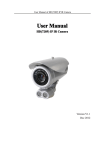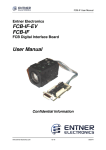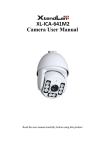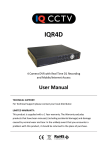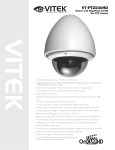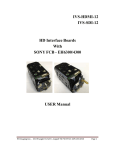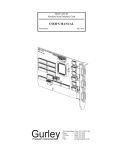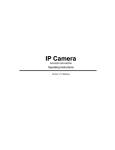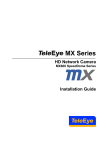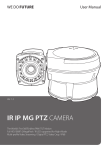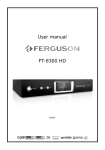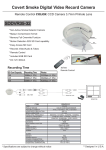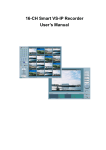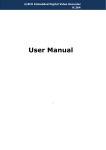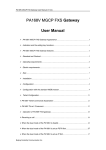Download TiSeriesIPPTZcamerasusermanual
Transcript
HD IP IR High Speed Dome Camera User Manual Read the user manual carefully before using this product May 2012 -1- Important Safeguards 1. During the course of transportation and storage, the product should be avoided from incorrect operations such as heavy pressing, strong vibration, soaking etc, which may cause damage to the unit. 2. The product is designed for wall-mount and pendant-mount installation, it can not be installed upside-down. And the module should be handled properly so as not to bring about mechanical problems affecting the integrative functions of it. 3. Do not let any foreign objects or liquid infiltrate into the unit, which may damage the machine. 4. Please follow all electrical standards for safety when it is being connected and adopt the particular power supply which is provided with the unit. The product adopts TVS-class lightning damage preventing technology, which can effectively prevent such pulse signal damage caused by lightning under 500W or electric surge. Video signal should be kept enough distance from high voltage equipments and cables when they are in transmission, and necessary steps should be taken to prevent lightning damage or power surge. 5. No matter the unit is ruining or not, the camera should never be aimed at the sun or object with extremely bright light. Otherwise, the camera’s CCD might be permanently damaged. 6. There are no parts inside the unit which can be repaired by the users themselves. When mechanical problems arise, do not be in a haste to do any repairing, please refer to the User’s Manual to find the trouble. If causes can not be located, please refer servicing to qualified professionals. All servicing must be done by authorized personnel. -2- Table of Content 1. Technical Data................................................................................ - 6 1.1 Dome Camera Technical Data .............................................. - 6 1.2 Internal Camera Technical Parameters ................................. - 7 1.3 Internet Technical Parameters............................................... - 9 2. Characteristics .............................................................................. - 11 2.1 Dome Camera Characteristics ............................................ - 11 2.2 Network Characteristics...................................................... - 12 3. Network Connection Method................................................ - 12 3.1 Direct Connect Mode.................................................. - 12 3.2 Network Connect Mode.............................................. - 12 3.3 Power On ............................................................................ - 13 4. Camera Function Setting .............................................................. - 14 4.1 Camera Protocol, Bit Rate, Address Setting ....................... - 14 4.2 Camera Function Setting Form........................................... - 14 5、IE Log In Interface...................................................................... - 16 5.1 Login Home Page ............................................................... - 16 5.1.1 Device Log In ....................................................... - 16 5.1.2 Home Page Instruction.......................................... - 19 5.1.3 Home Page Instruction.......................................... - 19 5.2 System Setting .................................................................... - 23 5.2.1 Basic Information ................................................. - 23 5.2.2 User Manage......................................................... - 25 5.2.3 Serial Port ............................................................. - 26 5.2.4 Device Record ...................................................... - 26 5.2.5 Net Record ............................................................ - 28 5.2.6 Time Setting.......................................................... - 29 5.2.7 Multiple Device .................................................... - 30 5.2.8 System Status........................................................ - 32 5.2.9 IR Sensor .............................................................. - 33 -3- 5.2.10 IR Setting ............................................................ - 33 5.2.11 Auto Update ........................................................... - 34 5.2.12 System Log ............................................................ - 35 5.3Audio Video......................................................................... - 36 5.3.1 Video Channel ...................................................... - 36 5.3.2 Video Set............................................................... - 37 5.3.3 Video Mask........................................................... - 38 5.3.4 Audio Settings ...................................................... - 40 5.3.5 Extend Configuration............................................ - 40 5.4 Network Settings ................................................................ - 41 5.4.1 Ethernet................................................................. - 41 5.4.2 PPPOE .................................................................. - 41 5.4.3 DDNS Settings...................................................... - 42 5.4.4 Port........................................................................ - 43 5.4.5 Network Check ..................................................... - 44 5.4.6 Docking Platform.................................................. - 44 5.5 Alarm Setting ...................................................................... - 45 5.5.1 Alarm In................................................................ - 45 5.5.2 Motion Detect ....................................................... - 46 5.5.3 Linkage Setting..................................................... - 48 5.5.4 Alarm Linkage ...................................................... - 48 5.6 Local Setting....................................................................... - 49 6. PTZ Control Basic Function...................................................... - 51 6.1 Preset Setting and Calling................................................... - 51 6.1.1 Preset Setting ........................................................ - 51 6.1.2 Calling for Preset Position .................................... - 51 6.2 Special Function Setting and Calling............................... - 52 6.2.1 Left/Right Scan Setting......................................... - 52 6.2.2 360 Scan................................................................ - 52 6.2.3 Tour Group Setting ............................................... - 52 6.2.4 Pattern Scan Setting .............................................. - 53 -4- 7. FAQ .............................................................................................. - 55 - -5- 1. Technical Data 1.1 Dome Camera Technical Data Power Supply Power Consumption Communication Baudrate Manually Horizontal Rotate Speed Manually Vertical Rotate Speed Horizontal Rotate Range Vertical Rotate Range Auto Flip Function Speed Auto-control as per the changing of zoom ratio Left & Right Scan Left & Right Scan Speed 360º Scan DC15V±10%(4A) 25W(Open high light IR lamp) 4800bps(Fix) 0.5º~120º/S,max 350º/S when rotate to preset position 0.5º~60º/S,max 120º/S when rotate to preset position 360ºno limit rotate 0 º~90º Auto-flip 180º when vertical 90° The pan/tilt can automatically adjust the running speed following the change of the zoom ratio Yes Low,Medium,High Low,Medium,High Pattern Scan 4 groups Number Preset Position 128 Number Tour Group 4 groups Number -6- Tour Group Preset Position 16 for each tour group Number Guard Function Yes Wiper Manually open or close Alarm Interface 4 ways in, 1 way out(optional) IR Lamp High-power IR IR Lamp Control Sensor mode and camera mode Brightness control for IR lamps Facial Recognition Distance Max Power Consumption for IR Lamp Working temperature Relative Humidity Weight Auto/Manual, can open the low, medium, high model manually 100m 13W -25‐~60‐ ≤95% no moisture condensation 6Kg(including the bracket) Protection Grade IP66 1.2 Internal Camera Technical Parameters Sonic Camera Technical Parameters(Version: FCB-EH6300) Image Sensor 1/2.8-type ‘Exmor’ CMOS Valid Pixel 3.27 Million Minimum Illuminance 0.095lux (ICR open,F1.6,50IRE) Close-up 10mm(W)~1000mm(T)(default to 300 mm) -7- camera shooting distance Aperture value F1.6(W)~F3.5(T) Focus Auto/Manual/Trigger zooming rate 20 times Optical variable times, 12 times digital variable times focal distance f=4.7mm(Wide-angle end) ~94mm(long distance) image angle 55.4°(Wide-angle end) ~2.9°(long distance) electronic shutter 1/1 to 1/10,000 s,22 steps optional White Balance Auto/Manual/Indoor/Outdoor Gain Control Auto/Manual Weight About260g Size(W×H×D) 50x60x87.9mm Working Temperature -5°C to 60°C Storage Temperature -20°C to 60°C Max Power Consumption 3.8W J20AH Camera Technical Parameters (Version: 3NCM86-J20AH) Image Sensor 1/2.9″,2.43Mega CMOS Sensor Valid Pixel 2.1 million Communication Interface VISCA protocol (TTL) Min Lightness 0.5lx (ICR 开, 1/30sec) -8- Synchronize Method Internal synchronize Scan Method 2:1 progressive scanning Aperture Auto/Manual Focus Auto/Manual Zooming Rate 20 times Optical variable times Focal distance f=4.7mm(Wide-angle end) ~94mm(long distance) Image angle 59°(Wide-angle end) ~3.3°(long distance) electronic shutter Auto/Manual White Balance Auto/Manual Gain Control Auto/Manual ICR Switch Auto/Manual Mirroring Up Down/Left Right Image Adjust Definition/contrast/color enhancement/brightness Weight About 260g size(W×H×D) 90.3x50.3x60mm Working temperature ‐5‐~+60‐ Max power consumption 3W 1.3 Internet Technical Parameters Processor Switch method DavinciTMS320DM368 in Ethernet -9- Video Compression Standard H.264 Audio Compression Standard AMR,G.711 Max Frame 25 Frame/S Rate Video Resolution 1920*1080(1080P) , 720*576(D1) , 352*288(CIF) , 176*144(QCIF) Stream Dual stream. Main stream can choose 1080P/D1, sub stream can choose D1/CIF/QCIF Video Compression Bit Rate 16Kbps~8Mbps Audio AMR:4.75Kbps~12.2Kbps;G.711:64Kbps Compression Bit rate Image Delay <200MS Net Interface RJ-45 10/100M Network adaptive Internet RTSP/HTTP/HTTPS//FTP/DHCP/MUDP/SMTP/CIFS/UPNP/PPPOE/ Protocol NTP/DDNS - 10 - Front End USB storage device can support maximum 500G, TF card Storage Device support maximum 16G(optional) Talkback 1 way MIC In input, 1 way Line out output(optional) Function Alarm 4 way in, 1 way out(optional) Interface Motion Detect Sensitivity 1~100% is adjustable, linkage alarm can be set 2. Characteristics 2.1 Dome Camera Characteristics The cover is constructed with aluminum alloy, which ensures compact structure, high shielding strength and excellent heat-dispersion effect. The lower part of the unit is designed as exposed, which effectively solve the heat-dispersion problem for the camera module and the IR lamps etc parts. Adopt wiper design for easy to clean the water or item from lens and gain clear image Adopt circus lifeline design to ensure the safety during installation Built in anti fog device to avoid fogging inside and ensure the image definition Latest LED Array technology is adopted for the IR lamp, LED Array has higher brightness, longer visible distance, more evenly distributed light field and much longer lifespan Driven by a stepper electric mortar, the unit runs smoothly, reacts quickly and locates positions accurately - 11 - Adopt EEPROM data storage method, data will not be lost when out of electricity Adopt conductive slide design, which can rotate 360°, no supervision dead zone Support PTZ auto flip function(vertical 180°auto flip and supervision) Support focus ratio control function(PTZ rotate speed can be adjusted base on lens zooming value) 2.2 Network Characteristics 1、 Standard H.264 video compression format 2、 Support 1080P,D1,CIF,QCIF video format, can output main and sub stream at the same time 3 、Built-in Web Server, fully support IE browser to surveillance, configure and mange device, simple and convenience to operate 4、 Dynamic bit rate control to ensure real time video transportation in internet 5、 Support multiple users to view video and can set log in authorization 6、 Support two way speech talkback 7、 Support motion detect 8、 Support image snapping 9、 Support image parameters adjust 10、Support linkage alarm 11、Support local and front end record and playback 3. Network Connection Method 3.1 Direct Connect Mode Connect the camera to PC by network directly. 3.2 Network Connect Mode Can connect the camera to internet, user can log in the device through client side software of browser. - 12 - There are two ways to connect to internet: Through PPPOE and DDNS Through router, as below figure Network Connection Diagram Attention: do not put the wire and network cable to places that will be easily touched by people, to avoid signal unstable caused by bad connection of lines and effect the quality of video. 3.3 Power On 1. Check the polarity of plug, socket and other connection, power on after confirmation 2. Camera will do self-checking, rotate 360º horizontally and 90º vertically for checking the camera lens, the electronic and machine structure for camera in horizontal and vertical status, after that, the camera will execute reset program and rotate to original. When the camera stop completely, the self-checking is finish and ready for controlling. - 13 - 4. Camera Function Setting 4.1 Camera Protocol, Bit Rate, Address Setting The setting for HD IP IR camera protocol, baud rate and address is fix and can't be changed. After self-checking, the system information for camera is as below: Protocol: PELCO-D BaudRate:4800bps Address: 1 DataBit:8 StopBit:1 ParityCheck:No 4.2 Camera Function Setting Form Tip: some special functions don't have coordinate command in 'PELCO-D' protocol, in order to control these functions, we have switched the function for some common use command.Normally will switch by 'change preset position/set preset position', this function will be introduced in 5.1.3, below list the command switch form: Invoke Preset Point No. Function for Preset Point Invoke Preset Point No. Function for Preset Point 130 Set left limit 195 Start the third tour group 131 Set right limit 196 The fourth tour group setting begin - 14 - 132 Start left/right scan(low speed) 197 The fourth tour group setting over 133 Start left/right scan(medium speed) 198 Start the fourth tour group 134 Start left/right scan(high speed) 180 The first setting for scan begin group pattern 184 The first setting for scan over group pattern 185 Start the frist group pattern scan 181 The second group setting for pattern scan begin 135 136 137 Start PTZ 360º scan(low speed) Start PTZ 360º scan(medium speed) Start PTZ 360º scan(high speed) 138 Stop PTZ auto scan 184 The second group setting for pattern scan over 140 The frist tour group setting begin 186 Start the second group pattern scan 141 The frist tour group setting over 182 The third setting for scan begin group pattern group pattern 142 Start the first tour group 184 The third setting for scan over 190 The second tour group setting begin 187 Start the third group pattern scan - 15 - 183 The fourth group setting for pattern scan begin 192 Start the second tour group 184 The fourth group setting for pattern scan over 193 The third tour group setting begin 188 Start the fourth group pattern scan 194 The third tour group setting over 150 Restart of camera 191 Stop PTZ auto scan 5、 、IE Log In Interface 5.1 Login Home Page 5.1.1 Device Log In Firstly, set the IP address segment of PC the same as the Device's. For example, the device IP address is 192.168.1.217, gateway 192.168.1.1. PC IP address should be 192.168.1.XX, gateway 192.168.1.1. Open the IE browser, input default IP address in address column, or visit through domain name if the domain name analytic function is in use, input domain name will display log in dialog box, as Fig 1-1. If user is not sure of the device address, can search it by using searching tool or client side software. - 16 - Fig 1-1 Log In Interface Original Status: Default Address 192.168.1.217 User Name admin operator user Password admin operator user Attention: use default user name to login successfully, then the user will have authorization for all kinds of operations. It's suggested that user to modify password after first log in for security. Click or can switch language For using this software for the first time will need to do below setting in IE. For first use user, he needs to install OCX ActiveX, or can't view video. Click Download OCXfile for installation. After successfully downloading, click OCX icon page will be shown up: for installation, below - 17 - Click 'Install' and below page will be shown up. - 18 - Click 'Finish' to complete the installation of OCX Input user name and password to enter IE home page. 5.1.2 Home Page Instruction After log in will enter the IE homepage, as Fig 1-2: Fig1-2 Home Page 5.1.3 Home Page Instruction 1、 、Tool Bar Instruction Fig 1-3-1-1 Tool Bar :Disconnect/Connect with device : Snap the current image and save to local PC(default path C:\IPCamera, user can modify it by local setting) :Save the current video to local PC :Record playback :User and controller talkback :Volume on/off :Select the area that need to zoom in :Zoom in the selected area :Display full screen of the current image - 19 - :Log out :Display alarm status Click 'Playback' button and a new window will be open as below figure. Fig 1-3-1-2 Record Playback Playback function includes search and play record: Search record: user can search record by record time and type. Select the begin and end time you want to search and choose record type, including local record and front end record, under each type there are alarm, schedule(PC doesn't have schedule record function), manual record. When the setting is finished, click 'Search',the record that suits the requirement will be listed Play Record: select the record that you want to play, click - 20 - 'Play' button or double click this record, record can be played on four screens on the left Use the tool bar on the top, you can pause, stop, slower or faster the record,you can also do snap, play by sequence, open/close volume. 2、 、Video Format Instruction Fig 1-3-2 Video Image Format HD IP Camera support dual stream, main stream supports 1080P and D1, sub stream supports D1, CIF, QCIF. In normal situation, 1080P and D1 suit for LAN, CIF suits for WAN, QCIF suits for mobile phone network. User can select stream according to actual use. 3、 、PTZ Control Fig 1-3-3 PTZ Control PTZ control includes focus+(focus-),zoom+(zoom-),wiper - 21 - open(wiper close),up, down, left, right and auto loop, user can drap the mouse to adjust PTZ rotate speed. 4、 、Preset Position Through setting of preset position, user can make the PTZ to certain position easily. Click 'Preset' button as Fig 1-3-4. Fig 1-3-4 Preset Position Setting Add preset position: input the preset title and number, click 'Add', the system will inform 'Preset add ok!'. (Different camera has different range for preset position, user can set ti according to actual situation) Delete preset position: click 'Delete' after select the preset position you want to delete, system will inform 'Preset delete ok!' Call preset position: select one of the preset position, click 'call', PTZ will switch to the position automatically, and the system will inform 'Preset call ok!' For more detail please '6. PTZ Basic Function Setting". 5、 、Preset Guard - 22 - Fig 1-3-5 Preset Guard Preset guard function: if user set a preset guard(a special preset position) and enable this function, when the device is in no operation status, it will execute guard position function after a period of time, PTZ will move to the guard position. Set guard position: select 'Enable Guard', select a preset position as guard position, set the idle time, click 'Set' button and save the parameters is ok. 5.2 System Setting 5.2.1 Basic Information Basic information will display current system information, user can execute software reboot, set default, auto reboot and so on. As Fig2-1. - 23 - Fig 2-1 Basic Information System Information: display current device name, device SN, kernel version, server version, web version and OCX version. Auto Reboot: user can set the time for auto reboot. The method is, firstly click the 'Enable' check box and set the reboot time, can set to everyday or one certain day, save it after finish setting. System Update: click the left-hand button, select the path of update document and click 'Confirm'. User can get the latest version through update the software. Attention: in the process of updating, please don't cut the electricity or do any other operation, or it may cause failure to update or destroy the system. System Operation: Set Default: return to default value Reboot: reboot the device - 24 - 5.2.2 User Manage In user manage you can add, delete or modify users. 1.Device Authentication When enable the device authentication, user should input the right name and password to log in the software; disable this function then user doesn’t need to input password, only need to input the right user name to log in. 2.User Password Setting User can create new user and set the group for new user. Fig 2-2 User Management Add: input new user name and password, select the user group, click ‘Add’ button, system will inform ‘Add Success!’ and the new user will be shown in the list below. Delete: select the user need to delete, click ‘Delete’, system will inform ‘Delete Success’, at the same time this user will be deleted from the list. Modify: Select the user need to modify, change the password, click ‘Modify’, system will inform ‘Modify Success!’. - 25 - 5.2.3 Serial Port The setting for serial post is fixed and can’t be changed. Fig 2-3 Serial Port 5.2.4 Device Record Attention: this function will be validated when the camera has internal TF card or connect with U disk. 1. Schedule Record Time Setting User can set the front end record time through time setting. Click the white box to select coordinate time, the color of the selected box will changed to orange. Attention: click the day on the left will select 24 hours of that day. Click ‘All’ will select all, and all of the box will change to orange color. Save the setting when it’s finished. - 26 - Fig 2-4 Device Record 2.Record manage User can set the disk strategy in case of the space of disk is not enough, it can be set to stop record of delete old file. Set the size of record, the range is 1 to 15 minutes. Set the length of alarm record when alarm occurs. Set the record size, totally there are four kinds of size: 1080P,720P,D1,CIF,QCIF. 3.Disk Status Connect storage device to device’s SD card slot and the information of it will be shown, including partition, total capacity, used capacity, free capacity and used percentage. When the setting for above parameters is finished, device will start recording if the free capacity is enough. Click ‘StartRec’, record status will display ‘Manual Record’, system begin to record, click ‘StopRec’to stop recording. During the time of device record, system will do record - 27 - automatically, record status will display ‘Record Schedule’. During the time of recording, user can select ‘Auto Flush’, system will do auto flush for the status of storage device automatically based on the time you set. When the storage device is connected with device, there are two ways to download documents from storage device: HTTP Download: can use HTTP method to download document to local disk FTP Download: can use FTP method to download document to local disk Click ‘Capture’can save the current image to storage device in the form of JPG. ‘Initialize’ button use for the SD card 5.2.5 Net Record Net record function enable the storage device in network to be used in front end. - 28 - Fig 2-5 Net Record 1.NFS Setting Record Switch: to open or close the NFS remote record function. Network path: input address for remote NFS Username: the user name to log in NFS Password: password for the username 2.SAMBA Setting Record Switch: to open or close SAMBA record function. Network path: input address for SAMBA Username: the user name to log in SAMBA Password: password for the username 5.2.6 Time Setting User can select time zone and adjust date and time. - 29 - Fig 2-6 Time Setting Zone Setting: select local time zone and click ‘Save’. Date Setting: can synchronize the date with local PC, click ‘Save’ to save the setting. NTP Settings: click the check box ‘Sync with NTP’, select one of the server and save, then system time will synchronize with the selected internet clock. 5.2.7 Multiple Device - 30 - Fig 2-7 Multiple Device Here user can add multiple devices, after that, user can operate multiple devices in home page. Setting method: input the IP address, port, username, password and related information in the column, select the right channel, click ‘Add’and return back to home page, then you can view and operate several devices by only log in one of them. Attention: to view several devices will require higher configuration PC, to enable this function in low configuration PC may affect the quality, user can select the No. of devices based on the situation of your PC, system support maximum 9 devices to display at the same time. - 31 - 5.2.8 System Status System status display the system status currently. Fig 2-8 System Status Select the time interval for flush, or click ‘Auto flush’, it can flush the system status automatically. Below is the information that system status will display: Sequence 1: display temperature information Sequence 2: display CPU use status Sequence 3: display clock CPU frequency Sequence 4: display RAM use status Sequence 5: display power on continuous time Sequence 6: display program operate continuous time Sequence 7: display system UPNP status Sequence 8: display ROUTE information Sequence 9: display DNS server information Sequence 10: display the IP address and resolution information of the video stream that connected with camera - 32 - 5.2.9 IR Sensor Click ‘IR Sensor’ will switch to below page. Fig 2-9 IR Sensor Here user can drag the mouse to set IR lux, the range is 1-100, when the environment brightness is lower than lux, IR lamp will be open. 5.2.10 IR Setting Click 'IR Setting' to enter below page - 33 - Fig 2-10 IR Info IR setting menu has IR lamp switch and IR lamp light model. IR lamp switch mode: user can select 'Sensor Model' or 'Camera Model' to open IR lamp. When user select 'Sensor Model', the camera sensor will determine whether to open IR lamp. When user select 'Camera Model', the inside camera will determine whether to open IR lamp. IR lamp brightness model: here user can select IR lamp brightness manual or auto model. When user select auto model, camera will choose different brightness based on inside camera times. User can also manually choose low, medium and high IR lamp. 5.2.11 Auto Update Click ‘Auto Update’ button to enter below page. - 34 - Fig 2-11 Auto Update In this page, click ‘open’ can begin to set the related parameters. Setting the right server URL, port, username, password and inquire time interval, system will do auto updated accordingly. 5.2.12 System Log Click ‘SysLog’ to enter below page. - 35 - Fig 2-12 System Log User can view system log here. 5.3Audio Video 5.3.1 Video Channel Select Audio Video and enter video channel page as Fig 3-1. 。 - 36 - Fig 3-1 Video Channel For different network status, user can select different video channel. HD IT IP High Speed Dome Camera support dual stream, main stream support 1080P and D1 video format, sub stream support D1, CIF,QCIF video format, user can open or close stream according to actual use and set related parameters. Playback fluency can choose high, middle and low. Save the parameters after setting, then system will require you to log in again. 5.3.2 Video Set Here is to set the contents show on the image, mainly include: device name, time and BPS. - 37 - Fig 3-2 Video Parameters User can select show or hide the device name, time and BPS. If user wants to show device name, he needs to input the name. Click ‘Save’ after setting finish. Attention: device name can’t exceed 12 characters. 5.3.3 Video Mask Through area mask, you can protect personal privacy from not display certain area in supervision video. When setting video mask, firstly need to select the mask color, which is in the form of number, and then select the sequence in index, click ‘Set’ button, click ‘Area’ and drag the mouse to select mask area(mask area can’t exceed 1/4 of the image). When the setting is finished, user can show, hide or delete this mask. - 38 - Fig 3-3 Video Mask Setting - 39 - 5.3.4 Audio Settings User can adjust the volume input and output based on actual situation, as Fig 3-4. Fig 3-4 Audio Settings Click ‘Save’ after the setting finish. If user wants to return to default value, select ‘Default’ and save. 5.3.5 Extend Configuration Fig 3-5 Extend Configuration - 40 - In ‘Extend Configuration’, user can select code size, code profile and code level. User can also enable or disable the BNC function. Click ‘Save’ after setting is finished. 5.4 Network Settings 5.4.1 Ethernet Through Ethernet setting, user can set related parameters for Ethernet. As Fig 4-1. Fig 4-1 Ethernet User can set network parameter based on actual situation, including DNS address, IP address, Subnet mask, gateway and so on. ‘Save’ after the setting is finished. Mac address is the physical address for device, it can’t be changed. DHCP setting: can open this function and get network parameters automatically from local network, to enable this function needs the support of DHCP server, please confirm with network administrator. 5.4.2 PPPOE When setting PPPOE auto dial, firstly need to enable the PPPOE - 41 - switch, then select the network card, input username and password provided by internet supplier, save after the setting is finished. Fig 4-2 PPPOE 5.4.3 DDNS Settings DDNS can map the dynamic IP address to a fix domain name. Before setting dynamic domain name analyze , you need open the switch. Select DDNS service supplier, 3322.0rg or 9299.org, input DDNS username and password and other parameters, save after finish setting. As Fig 4-3. - 42 - Fig 4-3 DDNS Setting 5.4.4 Port Select NetSetting and select Port to enter below page. Fig 4-4 Port WEB Port:the port use for log in device in IE FTP Port:the port use for FTP upload and download RTSP Port:real stream port, use for video stream transportation - 43 - Speak Port:the port use for speak talkback Update Port:the port use for software update UPNP Switch:Auto port mapping switch(need the support of router) 5.4.5 Network Check Fig 4-5 Network check 5.4.6 Docking Platform Different upgrade programs have different docking platform, here take industry docking platform for instance. - 44 - Fig 4-6 Docking Platform Enter the server page, as above Fig 4-6, select to enable or disable the accessing of server. Add the server address that coordinate with platform, port and heartbeat period and save. After saving the right parameter, server status will be displayed on the right, which can view real time connection status for each server. 5.5 Alarm Setting 5.5.1 Alarm In Select ‘Alarm In’, enter ‘Alarm Setting’ page and enter page as Fig 5-1. - 45 - Fig 5-1 Alarm In Attention: Click white column in time table, it will change to orange color Click the day on the left, the whole day will change to orange color Click ‘All’ will select all, the whole time table will change to orange color. 5.5.2 Motion Detect Select ‘Alarm Setting’ and enter ‘Motion Detect’,you will enter below page for motion detect setting. - 46 - Fig 5-2 Motion Detect Motion detect parameters: firstly click the check box to enable motion detect function, then set the sensitivity(1~100, the higher the sensitivity, the less motion is required to trigger recording). Click the radio button in front of ‘Select’, press Ctrl button and drag the mouse in the image to set motion detect area. Press the radio button in front of ‘Display’ and above page will be shown, as Fig 5-2. 1.Motion detect time schedule: set the motion detect front end time schedule can linkage motion detect alarm during selecting time(including front end record, email sending, FTP uploading and so on) Attention: Click white column in time table, it will change to orange color - 47 - Click the day on the left, the whole day will change to orange color Click ‘All’ will select all, the whole time table will change to orange color. 2.Save the parameters after setting finish. 5.5.3 Linkage Setting Select ‘Alarm Setting’ and select ‘LinkAttr’, as Fig 5-3. Fig 5-3 Linkage Setting Alarm center parameters: set alarm center address and port, save after setting finish. Email Parameters: set the email server, username and password and save, then system will send the alarm information to coordinate email. FTP Client Parameter: firstly input the FTP server name, username and password, FTP path and upload type, save after setting finish. 5.5.4 Alarm Linkage Select ‘Alarm Setting’ and enter ‘Alarm Linkage’ page, as Fig 5-4 - 48 - Fig 5-4 Alarm Linkage Alarm input linkage: select input channel, alarm interval and linkage option such as alarm center, Email, playsound and so on. Motion Detect: set motion detect alarm time interval, select linkage options, including alarm center, Email, record, FTPsend, play sound, capture(save the current image in the form of picture and save in mobile device) and so on. Simulate Alarm: this is for replacing probe and other devices to trigger alarm by pressing button. 5.6 Local Setting Select ‘Local Setting’ to enter below page. - 49 - Fig 6-1 Local Setting Local Storage Setting: firstly set the manual record time and then storage path. Pre Record Setting: open the pre record function for alarm record in IE. Alarm Linkage Record: click ‘Alarm Linkage Record’ can do linkage record when have alarm. Set the record size and save is ok. - 50 - 6. PTZ Control Basic Function Fig 1-3-4 Preset Position Setting 6.1 Preset Setting and Calling 6.1.1 Preset Setting Camera can set 128 preset position. User can move the PTZ to surveillance place and zoom+ or zoom- to adjust the image size. Input a number to represent for this preset position, and press ‘Add’ button to save the setting. Then the camera will save this surveillance position and the setting parameters. For instance: set No.1 preset position. - Move the PTZ to surveillance place and adjust the size. Input 1 to ‘Preset Num’ and input preset title Press ‘Add’ button to save this preset position, then the information will be shown in ‘Preset Select’. 6.1.2 Calling for Preset Position Input the preset No. in the text box after ‘Preset Num’, or click the drop down list from ‘Preset Select’ to choose the position you want, then press ‘Call’ button, PTZ will move to coordinate position accurately based on the parameters set before(including PTZ horizontal, vertical angle and lens variable value). For instance: call No.1 preset position - 51 - - Input 1 in the text box after ‘Preset Num’ or select one from ‘Preset Select’ - Press ‘Call’ button Camera execute new order, PTZ move, lens adjust and finally locate in the accurate No.1 position 6.2 Special Function Setting and Calling User can achieve left/right scan, 360º scan, pattern scan and camera reboot through calling special preset position. 6.2.1 Left/Right Scan Setting Input 130 in the text box after ‘Preset Num’, press ‘Call’ button, the current position is the left limit point for left/right scan, input 131 and press ‘Call’ button, the current position is the right limit point for left/right scan. When finish setting of the left/right limit point, input 132, camera will begin to do low speed left/right scan, input 133 medium speed scan and 134 high speed scan. 6.2.2 360 Scan Input 135 in the text box after ‘Preset Num’, press ‘Call’ button, camera will begin to do low speed 360º scan, input 136 for medium speed 360º scan and 137 for high speed’s. 6.2.3 Tour Group Setting 6.2.3.1 The First Tour Group Setting Input 140 in the text box after ‘Preset Num’, press ‘Call’ button, camera will begin the first tour group setting, select one preset position from ‘Play Select’, and press ‘Call’, then this preset position will be added to tour group, for each tour group can add 16 preset positions, after the adding finished, input 141 and the adding will be over, input - 52 - 142 to operate the first tour group. 6.2.3.2 The Second Tour Group Setting Input 190 in the text box after ‘Preset Num’, press ‘Call’ button, camera will begin the second tour group setting, select one preset position from ‘Play Select’, and press ‘Call’, then this preset position will be added to tour group, for each tour group can add 16 preset positions, after the adding finished, input 191 and the adding will be over, input 192 to operate the second tour group. 6.2.3.3 The Third Tour Group Setting Input 193 in the text box after ‘Preset Num’, press ‘Call’ button, camera will begin the third tour group setting, select one preset position from ‘Play Select’, and press ‘Call’, then this preset position will be added to tour group, for each tour group can add 16 preset positions, after the adding finished, input 194 and the adding will be over, input 195 to operate the second tour group. 6.2.3.4 The fourth Tour Group Setting Input 196 in the text box after ‘Preset Num’, press ‘Call’ button, camera will begin the fourth tour group setting, select one preset position from ‘Play Select’, and press ‘Call’, then this preset position will be added to tour group, for each tour group can add 16 preset positions, after the adding finished, input 197 and the adding will be over, input 198 to operate the second tour group. 6.2.4 Pattern Scan Setting Input 180 in the text box after ‘Preset Num’, press ‘Call’ button, operate the camera(camera control, lens control) to execute the first pattern scan;track record;Input 181 in the text box after ‘Preset Num’, press ‘Call’ button, operate the camera(camera control, lens control) to - 53 - execute the first pattern scan;track record;Input 182 in the text box after ‘Preset Num’, press ‘Call’ button, operate the camera(camera control, lens control) to execute the first pattern scan;track record; Input 183 in the text box after ‘Preset Num’, press ‘Call’ button, operate the camera(camera control, lens control) to execute the first pattern scan;track record; Input 184 in the text box after ‘Preset Num’, press ‘Call’ button to end the pattern pattern scan setting. Input 185,186,187,188 in the text box after ‘Preset Num’, press ‘Call’ button,camera will operate the first, second, third and fourth pattern scan. - 54 - 7. FAQ 1. Can Not Visit Via Browser Possible Reason(1) : Internet is not connected Solving Method: connect the PC to internet and check if it can normal work, get rid of cable and virus problem, till PCs can ping to each other. Possible Reason(2) : IP address is being occupied by other devices Solving Method:connect the camera to PC and reset a new IP address Possible Reason(3) : camera and PC IP address not in the same segment Solving Method:set them to the same segment Possible Reason(4) : Camera breakdown Solving Method: return for repairing 2. Can Not Control Camera Via IE Possible Reason(1) : Ensure if the settings of address, protocol and other parameters in 'Serial Port' are coordinate with the camera dial-up. Solving Method: check the camera protocol, bit rate and other parameters in 'Serial Port' and set them right. Possible Reason(2) : Camera breakdown Solving Method: return for repairing - 55 -























































